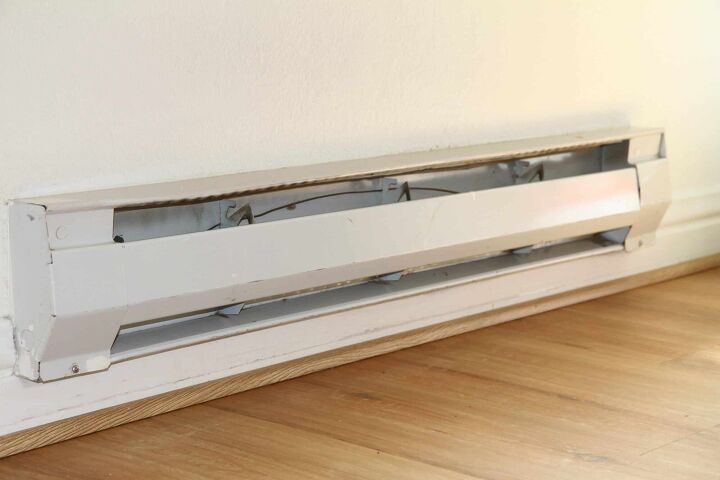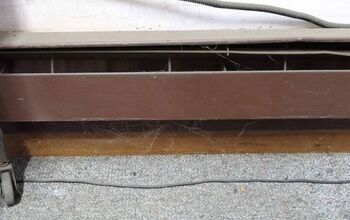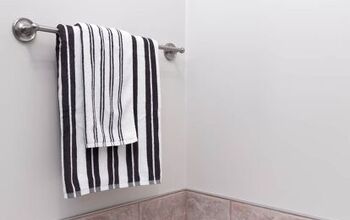How Do I Remove A Baseboard Heater From The Wall?

Baseboard heaters are electrical units that sit at the base of the wall and generate heat. They are very common in older homes, but no longer preferred in newer houses. Because they cannot monitor room temperatures, they are less efficient and more expensive to operate than most newer systems. When you are ready to make the switch, it is very easy to do this removal as a DIY project.
Turn off the baseboard heater at the circuit breaker, unscrew and remove the baseboard heater, open the wire panel box, and cut the wires. Cap the wires with wire nuts, secure them with electrical tape, and install a wall patch. Buff and sand the wall to clean the surface.
Before we delve into the detailed steps, you should understand the full plan and gather all your tools. Because the baseboard heater is connected to your electricity, this project can be dangerous. Be sure to prepare in advance and pay attention at all times in order to stay safe.
Do You Need to Hire an Electrician?
Get free, zero-commitment quotes from pro contractors near you.

Materials You Will Need
To remove your baseboard heater from the wall, you will need the following tools and materials:
Tools
- Screwdriver, Electric Screwdriver, or Power Drill
- Wire Cutter
- Putty Knife
- Sandpaper
- Paintbrush
- Optional: Utility Knife
Materials
- Wire Nuts
- Electrical Tape
- Wall Patch
- Putty
- Primer
- Paint
Step One: Turn Off the Power to the Heater
First, go to your home circuit breaker box, and flip the power to the baseboard heater to the off position. If you have an older breaker box, please do this cautiously. Not only can it be dangerous, but also it is expensive to fix breaker box switches.
When you return to the baseboard heater, be sure to test it to make sure it is no longer connected to power. You do not want to skip this step, as failure to properly turn off the system could result in electric shock.
Step Two: Unscrew and Remove the Baseboard Heater from the Wall
Use an electric screwdriver or power drill to remove the screws that are holding your baseboard heater to the wall. Once it is no longer attached, you can simply take it off the wall. For longer elements, consider enlisting help so you do not damage your wall or floor in the process.
It is common for the unit to be a little stuck, especially if it has been there for decades. You can use a screwdriver or utility knife to cut away any caulk or paint holding it to the wall. Cut as close to the unit as possible and prioritize protecting your wall.
When completing this step, you will want to be as gentle as possible. Do not use a crowbar to pry it off the wall. You will risk damaging the drywall or tearing the paint from the wall. Be careful to save yourself from having to make additional repairs to the wall.
Step Three: Expose and Cut the Wires
Use a screwdriver or power drill to unscrew and open the wire panel box. Again, please double-check that the power to the heater is off before moving forward.
Use a wire cutter to clip the wires connecting the baseboard heater to the wall. When you are completing this step, try to cut the wires as close as possible to the heater. This will preserve the maximum amount of wiring, in case you want to hook something else up here in the future.
Furthermore, try to cut the wires as precisely and carefully as possible. You will thank yourself for leaving behind neat wiring when you go to reuse it.
Step Four: Cap and Secure the Wires
Screw wire nuts to the ends of the wires, and wind them together so they are well organized. However, make sure the tips are set apart from each other. This is the safest way to secure the wires and prevent any chance of accidents from occurring.
Finally, tape the wires in place using electrical tape. You can also use electrical tape to further secure the wire nuts to the wire. When taping them in place, it is ideal to tape them directly inside the hole in your wall. Then, you can cap off the wall until you need to use the wires again.
Step Five: Install and Seal a Wall Patch
Especially if you have children or pets in your house, it is essential to seal off the wires. Once they are securely in the wall, place a wall patch or cover over the hole. You can buy one that screws into the wall or use glue or caulk to secure it.
Either way, it is important that the patch is well secured and not likely to fall out. Not only does this protect your family, but also it hides an unsightly hole.
Step Six: Repair the Wall
No matter how carefully you removed the baseboard heater, there will still be some wall repairs needed. There will be screw holes and likely scuff marks. Sand down any excess caulk or drywall sticking out of the screw holes.
Make sure the wall is clean and use putty to fill in any holes and scrapes. Once the putty is dry, you will need to sand again to ensure it is smooth. Finally, prime and paint over the area, and no sign of the baseboard heater will be left behind!
Hiring a Professional
Now that you know how to remove a baseboard heater, you can make an informed decision about doing it yourself. Below is a chart to help you compare and decide for yourself.
| Do It Yourself | Hire a Professional |
| The total cost will be maybe $30. | Hiring a contractor can cost anywhere from $100-$200, depending on location and season. |
| Total time will take maybe one or two hours. | Less than one hour. |
| The danger of electrocution is very serious, but the risk is low if you stay alert and safe. | A professional contractor will be trained to safely execute electrical work. |
Hiring a professional will give you the peace of mind to know that the removal was done safely and securely. If you have never handled wires before, it might be best to let a professional do it.
If you are installing a new system in place of the old one, a contractor can help you prepare the space. However, you may choose to do this project yourself to save money for the reinstallation.
Do You Need to Hire an Electrician?
Get free, zero-commitment quotes from pro contractors near you.

Related Questions
Why won’t my baseboard heater turn off?
Thermostats can suffer a number of problems and cause them, too. If your heater won’t turn off, it is likely caused by a malfunctioning thermostat. Once you replace the thermostat, your baseboard heater should turn off normally.
Should I ditch my baseboard heater?
Baseboard heaters use a lot of energy and produce inconsistent and uneven heat. They also require regular maintenance, making them costly in the long run. Other heating systems will be more costly upfront but are much better investments.
What sandpaper should I use to fix drywall?
You may need a couple of different grits for the whole project, depending on how much puttying you have to do. Medium should do the trick. We suggest using 150-grit sandpaper for finishing drywall.

We are a team of passionate homeowners, home improvement pros, and DIY enthusiasts who enjoy sharing home improvement, housekeeping, decorating, and more with other homeowners! Whether you're looking for a step-by-step guide on fixing an appliance or the cost of installing a fence, we've here to help.
More by Upgraded Home Team



























